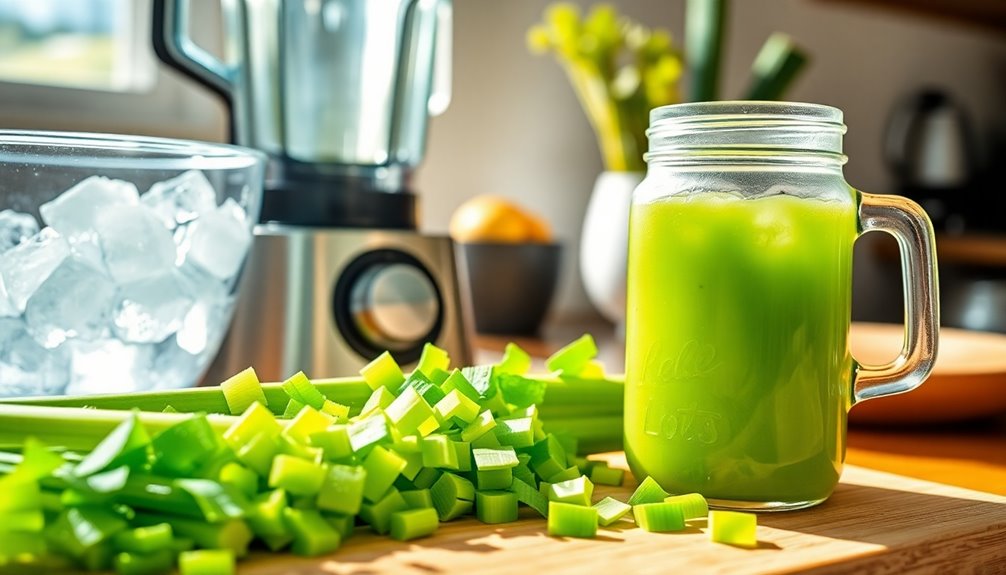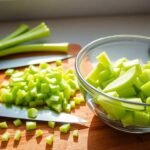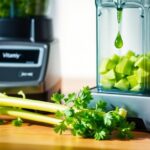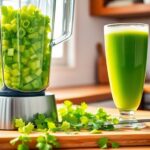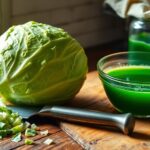To make celery juice without a juicer, start by rinsing and chopping fresh celery stalks. Blend the chopped celery with a bit of water until smooth. Then, strain the mixture using a fine mesh strainer or nut milk bag to separate the juice from the pulp. Squeeze out as much liquid as possible. Store the juice in a jar and enjoy it fresh for the best health benefits. There's more to discover about the advantages of celery juice!
Key Takeaways
- Rinse and chop fresh celery stalks into smaller pieces for easier blending.
- Blend the chopped celery with a little water until smooth for maximum juice extraction.
- Use a fine mesh strainer or nut milk bag to separate the juice from the pulp.
- Squeeze the strainer or bag to extract all the liquid, discarding the leftover pulp.
- Store the fresh celery juice in a glass jar and consume immediately for health benefits.

If you've ever wanted to enjoy the refreshing benefits of celery juice but don't own a juicer, you're in luck. You can easily make a pitcher of fresh celery juice right in your kitchen using just a blender or food processor. The process is straightforward and doesn't require any fancy equipment. All you need are some fresh celery stalks and a few common kitchen tools.
Start by rinsing the celery thoroughly under cold water to remove any dirt or impurities. It's essential to ensure that your celery is clean, especially since you'll be consuming it in liquid form.
After rinsing, chop the celery into smaller pieces. This not only makes blending easier but also helps to extract as much juice as possible. You want to make sure you're getting the most out of your celery.
Next, throw the chopped celery into your blender or food processor. If you find that the celery is too thick to blend smoothly, you can add a small amount of water—about 1/4 cup should do the trick. This little addition will help create an easy celery juice consistency.
Blend the mixture until it's completely smooth. The goal is to break down the celery thoroughly so that you can get all the juice out.
Once you've blended your celery, it's time to extract the juice. Grab a fine mesh strainer or a nut milk bag and place it over a bowl or measuring cup.
Pour the blended celery mixture into the strainer, allowing the juice to flow through while trapping the pulp. Use your hands to squeeze the strainer or bag to extract as much liquid as possible. You want to get every drop of that nutritious juice!
Once you've squeezed out all the juice, discard the pulp.
Now you've got your fresh celery juice ready to drink! Pour it into a glass or a mason jar for easy storage. It's best to enjoy it immediately to take full advantage of its health benefits.
Drinking celery juice first thing in the morning on an empty stomach can kickstart your digestion and help reduce bloating throughout the day. Make it a part of your morning routine, and you'll likely notice the positive effects it has on your overall well-being.
Frequently Asked Questions
Can I Juice Celery Without a Juicer?
Yes, you can juice celery without a juicer!
Just chop the celery into manageable pieces and blend it with a little water to create a smooth mixture.
Once blended, strain the mixture using a nut milk bag or fine mesh strainer, squeezing out the juice while discarding the pulp.
You'll get about 16-20 ounces of fresh juice from one bunch.
Remember to drink it right away for maximum health benefits!
What Are the Side Effects of Drinking Celery Juice on an Empty Stomach?
Drinking celery juice on an empty stomach can lead to several side effects.
You might experience digestive discomfort, including bloating or gas, due to its high fiber content.
It's also possible to feel lightheaded or dizzy from a temporary drop in blood sugar levels.
Increased urination is common because celery acts as a natural diuretic.
If you have celery allergies, be cautious, and be prepared for mild detox symptoms like headaches as your body adjusts.
How to Juice Celery by Hand?
To juice celery by hand, start by washing the stalks thoroughly and chopping them into smaller pieces. Next, place the chopped celery pieces into a blender or a juicer, ensuring you don’t overload the machine. Blend until smooth, then strain the mixture through a fine mesh sieve or cheesecloth to separate the juice from the pulp. If you’re looking for a quick method, check out a celery juice recipe for vitamix that allows you to make this refreshing drink with minimal effort and maximum flavor.
You can use a blender with a little water to help blend the celery until smooth.
Once blended, strain the mixture through a nut milk bag or a fine mesh strainer, squeezing to extract as much juice as you can.
Discard the leftover pulp, and enjoy your fresh celery juice right away for the best flavor!
Can I Just Blend Celery Instead of Juicing?
You know what they say: "Where there's a will, there's a way."
Yes, you can definitely blend celery instead of juicing it! Just chop it up, add a bit of water, and blend until smooth.
You'll keep more fiber this way, which is great for your digestion. If you want a pulp-free drink, simply strain the mixture.
It's an easy, quick method that gives you a nutritious boost without needing a fancy juicer!
Conclusion
Now that you know how to whip up celery juice without a juicer, imagine the refreshing taste and health benefits waiting for you. Picture yourself sipping on this vibrant green elixir, packed with nutrients and flavor. But what if this simple drink could transform your mornings and boost your energy levels? Give it a try and discover the hidden potential of celery juice. You might just unlock a new favorite ritual that leaves you craving more.
Cindy thoroughly researches juicing trends, techniques, and recipes to provide readers with practical advice and inspiration. Her writing style is accessible, engaging, and designed to make complex concepts easy to understand. Cindy’s dedication to promoting the advantages of juicing shines through her work, empowering readers to make positive changes in their lives through the simple act of juicing.

